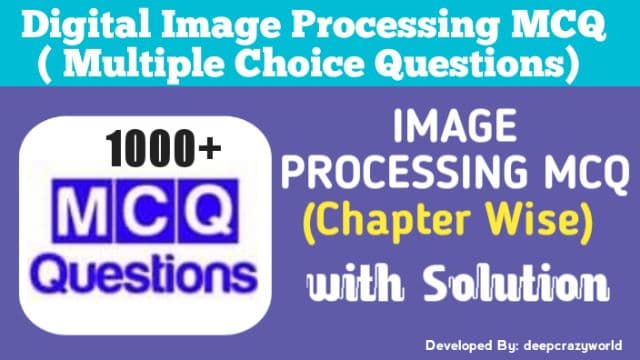Digital Image Processing Multiple Choice Questions
- 1000+ Multiple Choice Questions & Answers (MCQs) in Digital Image Processing MCQ with a detailed explanation of every question.
- These MCQs cover theoretical concepts, true-false statements, fill-in-the-blanks and match the following style statements.
- These MCQs are organized chapter wise and each Chapter is further organized topic wise.
- Every MCQ set focuses on a specific topic of a given Chapter in Digital Image Processing Subject.
Who should Practice Digital Image Processing MCQs? - Anyone preparing for Aptitude test in Digital Image Processing.
- Anyone preparing for interviews (campus/off-campus interviews, walk-in interview and company interviews).
- Anyone preparing for entrance examinations and other competitive examinations.
- All – Experienced, Freshers and College / School Students.
Digital Image Processing All Chapters
Here’s the list of chapters on the “Digital Image Processing” subject covering 100+ topics. You can practice the MCQs chapter by chapter . digital image processing mcq questions

DIP ALL CHAPTERS
- Basic of Digital Image Processing
- Digital Image Fundamentals
- Intensity Transformations and Spatial Filtering
- Filtering in Frequency Domain
- Image Restoration and Reconstruction
- Color Image Processing
- Image Compression
- Morphological Image Processing
- Image Segmentation
- Representation and Description
- Wavelet based Image Processing
- Image Enhancement
- Object Recognition
Basic of Digital Image Processing
The section contains multiple choice questions and answers on digital image processing introduction, steps and components.
TOPICS
1. Introduction to Digital Image Processing
2.Steps in Image Processing
3.Components of Image Processing System

This set of Digital Image Processing MCQ Multiple Choice Questions & Answers focuses on
“Introduction to Digital Image Processing”
- The spatial coordinates of a digital image (x,y) are proportional to:
a) Position
b) Brightness
c) Contrast
d) Noise
Answer: b
Explanation: The Brightness levels are distributed over the spatial area. Hence, the spatial coordinates are proportional to brightness levels.
- Among the following image processing techniques which is fast, precise and flexible.
a) Optical
b) Digital
c) Electronic
d) Photographic
Answer: b
Explanation: Digital image processing is more flexible and agile techniques as it is fast, accurate and reliable.
- An image is considered to be a function of a(x,y), where a represents:
a) Height of image
b) Width of image
c) Amplitude of image
d) Resolution of image
Answer: c
Explanation: The image is a collection of dots with a definite intensity or amplitude.
- What is pixel?
a) Pixel is the elements of a digital image
b) Pixel is the elements of an analog image
c) Pixel is the cluster of a digital image
d) Pixel is the cluster of an analog image
Answer: a
Explanation: An Image is a collection of individual points referred as pixel, thus a Pixel is the element of a digital image.
- The range of values spanned by the gray scale is called:
a) Dynamic range
b) Band range
c) Peak range
d) Resolution range
Answer: a
Explanation: The valued spanned in gray scale image are depicted using dynamic range values.
- Which is a colour attribute that describes a pure colour?
a) Saturation
b) Hue
c) Brightness
d) Intensity
Answer: b
Explanation: The color attribute of an image refers to the contrast of colors, which can be controlled using the Hue values.
- Which gives a measure of the degree to which a pure colour is diluted by white light?
a) Saturation
b) Hue
c) Intensity
d) Brightness
Answer: a
Explanation: Saturation is color recognizing capability of the human eye. Hence a degree of dilution is measured using saturation.
- Which means the assigning meaning to a recognized object.
a) Interpretation
b) Recognition
c) Acquisition
d) Segmentation
Answer: a
Explanation: The interpretation is called the assigning meaning to recognized object.
- A typical size comparable in quality to monochromatic TV image is of size.
a) 256 X 256
b) 512 X 512
c) 1920 X 1080
d) 1080 X 1080
Answer: b
Explanation: A normal T.V have 512 x 512 resolution.
- The number of grey values are integer powers of:
a) 4
b) 2
c) 8
d) 1
Answer: b
Explanation: The gray values are interpreted as the power of number of colors. In monochromatic image the number of colors are 2.
This set of Digital Image Processing MCQ ( Multiple Choice Questions & Answers ) focuses on
“Steps in Image Processing”
- What is the first and foremost step in Image Processing?
a) Image restoration
b) Image enhancement
c) Image acquisition
d) Segmentation
Answer: c
Explanation: Image acquisition is the first process in image processing. Note that acquisition could be as simple as being given an image that is already in digital form. Generally, the image acquisition stage involves preprocessing, such as scaling.
- In which step of processing, the images are subdivided successively into smaller regions?
a) Image enhancement
b) Image acquisition
c) Segmentation
d) Wavelets
Answer: d
Explanation: Wavelets are the foundation for representing images in various degrees of resolution. Wavelets are particularly used for image data compression and for pyramidal representation, in which images are subdivided successively into smaller regions.
- What is the next step in image processing after compression?
a) Wavelets
b) Segmentation
c) Representation and description
d) Morphological processing
Answer: d
Explanation: Steps in image processing:
Image acquisition-> Image enhancement-> Image restoration-> Color image processing-> Wavelets and multi resolution processing-> Compression-> Morphological processing-> Segmentation-> Representation & description-> Object recognition.
- What is the step that is performed before color image processing in image processing?
a) Wavelets and multi resolution processing
b) Image enhancement
c) Image restoration
d) Image acquisition
Answer: c
Explanation: Steps in image processing:
Image acquisition-> Image enhancement-> Image restoration-> Color image processing-> Wavelets and multi resolution processing-> Compression-> Morphological processing-> Segmentation-> Representation & description-> Object recognition.
- How many number of steps are involved in image processing?
a) 10
b) 9
c) 11
d) 12
Answer: a
Explanation: Steps in image processing:
Image acquisition-> Image enhancement-> Image restoration-> Color image processing-> Wavelets and multi resolution processing-> Compression-> Morphological processing-> Segmentation-> Representation & description-> Object recognition.
6. What is the expanded form of JPEG?
a) Joint Photographic Expansion Group
b) Joint Photographic Experts Group
c) Joint Photographs Expansion Group
d) Joint Photographic Expanded Group
Answer: b
Explanation: Image compression is familiar (perhaps inadvertently) to most users of computers in the form of image file extensions, such as the jpg file extension used in the JPEG (Joint Photographic Experts Group) image compression standard.
7. Which of the following step deals with tools for extracting image components those are useful in the representation and description of shape?
a) Segmentation
b) Representation & description
c) Compression
d) Morphological processing
Answer: d
Explanation: Morphological processing deals with tools for extracting image components that are useful in the representation and description of shape. The material in this chapter begins a transition from processes that output images to processes that output image attributes.
8. In which step of the processing, assigning a label (e.g., “vehicle”) to an object based on its descriptors is done?
a) Object recognition
b) Morphological processing
c) Segmentation
d) Representation & description
Answer: a
Explanation: Recognition is the process that assigns a label (e.g., “vehicle”) to an object based on its descriptors. We conclude our coverage of digital image processing with the development of methods for recognition of individual objects.
9. What role does the segmentation play in image processing?
a) Deals with extracting attributes that result in some quantitative information of interest
b) Deals with techniques for reducing the storage required saving an image, or the bandwidth required transmitting it
c) Deals with partitioning an image into its constituent parts or objects
d) Deals with property in which images are subdivided successively into smaller regions
Answer: c
Explanation: Segmentation procedures partition an image into its constituent parts or objects. In general, autonomous segmentation is one of the most difficult tasks in digital image processing. A rugged segmentation procedure brings the process a long way toward successful solution of imaging problems that require objects to be identified individually.
10. What is the correct sequence of steps in image processing?
a) Image acquisition->Image enhancement->Image restoration->Color image processing->Compression->Wavelets and multi resolution processing->Morphological processing->Segmentation->Representation & description->Object recognition
b) Image acquisition->Image enhancement->Image restoration->Color image processing->Wavelets and multi resolution processing->Compression->Morphological processing->Segmentation->Representation & description->Object recognition
c) Image acquisition->Image enhancement->Color image processing->Image restoration->Wavelets and multi resolution processing->Compression->Morphological processing->Segmentation->Representation & description->Object recognition
d) Image acquisition->Image enhancement->Image restoration->Color image processing->Wavelets and multi resolution processing->Compression->Morphological processing->Representation & description->Segmentation->Object recognition
Answer: b
Explanation: Steps in image processing:
Image acquisition-> Image enhancement->Image restoration->Color image processing->Wavelets and multi resolution processing->Compression->Morphological processing->Segmentation->Representation & description->Object recognition.
All Unit MCQ’s Questions of Image Processing 2021
Digital Image Processing Multiple choice Questions unit wise 2021
READ MORE…
If you found this post useful, don’t forget to share this with your friends, and if you have any query feel free to comment it in the comment section.
Thank you 😊 Keep Learning !
